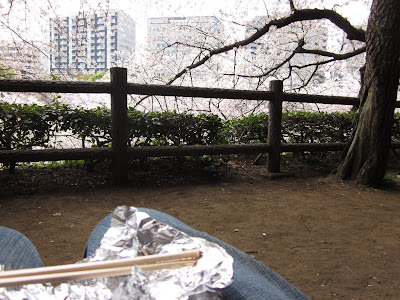If you couldn't guess from the title, these cherry blossoms are all near the Emperor's Palace in Tokyo. Mainly located in the northern area of the palace, many cherry blossom trees line the moat that surrounds this area. As you could imagine for this area, the views during hanami are simply breathtaking as the paths and banks are covered in the light pink and white blossoms of the many trees in the area. We went here on April 10th this year.
 |
| Leading up to Kitanomaru Park, which has the Budokan (the national martial arts hall). |
 |
| Looking over the embankments on the Imperial Palace side. |
 |
| Our simple hanami. |
 |
| Lunch with a view. |
 |
| The gate heading back out across the moat. |
 |
| There was a place to rent boats to go around the moat, but the line like most popular things in Tokyo was incredibly long. Maybe next year. |
 |
| Starting our way around the moat. |
 |
| The Budokan: Was made for the Judo arena during Japan's 1964 Olympics. Besides martial arts, it is famous for hosting music concerts, most notably the Beatles' first concerts in Japan. [1] |
In the last entry, I explained a little about the importance of the cherry blossom in Japan's culture. Maybe this next picture will look similar to the one above it.
 |
| Japan's 100 yen coin. Worth about $1.20 now, but think of it as a Japan dollar bill equivalent. |
The end of the Sakura season brings the prettiest sight of the season, but also one with a twinge of sadness, as it marks the end of the cherry blossoms for that year.
桜吹雪: Cherry Blossom Blizzard (さくらふぶき, sakura fubuki)
Towards the end of the season, the trees start to lose a lot of their petals at once, especially when a breeze comes by. All of the petals dropping makes the area look like it's snowing, even though it is just the cherry blossom petals. It is by far the prettiest part of the cherry blossom season, but also bittersweet; for once they fall off the tree, that is it for the sakura until next year.
This transition from the blooming process, to full bloom and the final beauty of the sakura fubuki before disappearing for the year also has a significant cultural symbolism in Japan. The great beauty of the cherry blossoms, tempered by its fragility and short blooming period of only a few weeks carries the symbolism of human's own mortality in Japan. Drawing from Buddhism and early Japanese culture, this feeling of creating a bright beauty in the short time of life and then its bittersweet passing is a common motif in Japan culture and literature. It never takes a stronger meaning than the cherry blossom season every spring. While we would have gone to more places, the cherry blossoms had all disappeared by the time the next weekend came. This year it lasted from the end of March till early in April. I'll have to wait for next spring to catch another glimpse of their brilliance here.
References:
1. Duncan, Bartlett, "Japan Keeps Lennon's Memory Alive," BBC.
http://news.bbc.co.uk/2/hi/entertainment/7770865.stm.










No comments:
Post a Comment